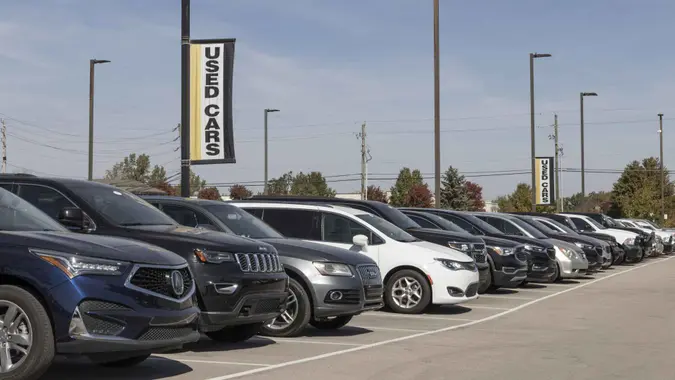11 Car Ownership Costs That Have Skyrocketed Since 2020

Commitment to Our Readers
GOBankingRates' editorial team is committed to bringing you unbiased reviews and information. We use data-driven methodologies to evaluate financial products and services - our reviews and ratings are not influenced by advertisers. You can read more about our editorial guidelines and our products and services review methodology.

20 Years
Helping You Live Richer

Reviewed
by Experts

Trusted by
Millions of Readers
The cost of owning a car has risen 39% since 2020, according to a new report from the Navy Federal Credit Union. That’s due in large part to the rapidly rising prices of both new and used cars, as well as auto insurance and repair costs.
But those aren’t the only costs that have increased over the past four years. Here’s a closer look at why owning a car has become much more expensive since the pandemic.
How Much Car Ownership Costs Have Increased Since 2020
The Navy Federal report illustrates just how much individual car ownership costs have increased over the past four years. Here’s a look at how much each cost has increased since 2020.
- Motor vehicle repair: 48%
- Motor vehicle insurance: 46%
- Motor vehicle bodywork: 31%
- Used cars and trucks: 30%
- Gasoline (all types): 29%
- Motor vehicle maintenance and servicing: 27%
- Tires: 22%
- Vehicle accessories other than tires: 21%
- New vehicles: 20%
- Parking and other fees: 11%
- State motor vehicle registration and license fees: 7%
Seven of these costs have risen at rates higher than the overall rate of inflation, as tracked by the consumer price index, which was 21% over that time period.
What Has Caused Car Ownership Costs To Skyrocket?
Several factors have led to a jump in car ownership costs from 2020 to now.
“The original shock to the car buying market was [caused by the] lack of microchips because of [factory shutdowns during] COVID,” said Robert Frick, corporate economist at Navy Federal.
With fewer new cars being produced, Americans were forced to buy used cars instead.
“That decreased the supply of used autos significantly, making them incredibly expensive,” Frick said. “Without supply, that just pushes up car prices, so that’s one thing. [In addition], a lot of people were forced to buy older-model, high-mileage used cars because they were the only thing affordable and available two or three years ago.”
More older car models on the road means more demand for repairs. This has increased the costs of repairs — both in terms of parts and labor — and with that, insurance costs have also increased.
“Many of our members are just one blown transmission away from financial disaster,” Frick said. “That’s true because it’s hard to get parts, labor is expensive and you have all these old model cars coming in for these huge repairs.”
How To Save on Car Ownership Costs
Despite the increased costs that come along with owning a car, there are still strategic ways to save. The best way to save money is to opt for an affordable used car over a new one, Frick said.
“Used car prices have come down now,” Frick said. “[They’re] still much higher than pre-pandemic, but a lot of dealers are now dealing used cars, so you can get a better deal. A year ago, it was a seller’s market. That’s changed a lot. Prices are down about 13 percentage points.”
Frick also said to opt for car models that are known to be reliable.
“Buy a car with a really good service record, so it won’t be in for as many repairs, and a great long-term warranty,” he said. “Selecting your car now is so much more important than it has been in the past. When you get your next car, get a cheaper, more dependable car, and all of a sudden your costs will be dramatically less.”
In addition, Frick recommended renegotiating your insurance policy every year.
“The floor for all insurance costs has risen, but you should always, once a year, reprice your auto insurance,” Frick said. “You probably won’t get the huge savings that you’ve gotten up until now, but the car insurance market is very competitive.”
 Written by
Written by  Edited by
Edited by 




























